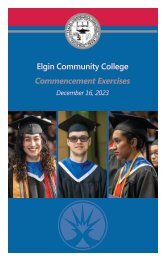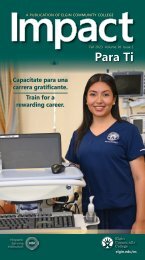ILEA Equity Plan | Elgin Community College (ECC)
There are wide and persistent gaps in college completion rates in Illinois, especially among students of color and low-income students. After an in-depth analysis of our institutional data, Elgin Community College (“ECC” or “the College” or “we” or “our”) has developed an Equity Plan containing annual growth targets for which progress updates will be shared publicly over the next five years. Our Equity Plan reflects the unique characteristics of our institution. For example, ECC is designated as a Hispanic Serving Institution by the US Department of Education, with just over 42% of the students identifying as Latinx or Hispanic. Also, the district served by ECC is widely diverse in terms of income and educational attainment. We will identify the obstacles students face and develop programs and policies that break down unnecessary college graduation barriers. Along with our fellow colleges, in the Partnership for College Completion organization, with this Illinois Equity in Attainment (“ILEA”) plan, we pledge to close the completion gaps by 2025.
There are wide and persistent gaps in college completion rates in Illinois, especially among students of color and low-income students. After an in-depth analysis of our institutional data, Elgin Community College (“ECC” or “the College” or “we” or “our”) has developed an Equity Plan containing annual growth targets for which progress updates will be shared publicly over the next five years. Our Equity Plan reflects the unique characteristics of our institution. For example, ECC is designated as a Hispanic Serving Institution by the US Department of Education, with just over 42% of the students identifying as Latinx or Hispanic. Also, the district served by ECC is widely diverse in terms of income and educational attainment. We will identify the obstacles students face and develop programs and policies that break down unnecessary college graduation barriers. Along with our fellow colleges, in the Partnership for College Completion organization, with this Illinois Equity in Attainment (“ILEA”) plan, we pledge to close the completion gaps by 2025.
You also want an ePaper? Increase the reach of your titles
YUMPU automatically turns print PDFs into web optimized ePapers that Google loves.
3C. Interim Benchmark Goals<br />
Ultimately, as part of PCC’s <strong>ILEA</strong> initiative, along with 27 other colleges and universities in<br />
Illinois, we are committed to eliminating racial and socio-economic achievement gaps while<br />
aggressively increasing completion rates among these target populations by 2025. After<br />
identifying each of the gaps in the Leading Indicators and Degree Completion metrics, we had<br />
to determine what targets to use that would demonstrate that the gaps are closed. This posed<br />
a couple of challenging issues: 1) Our data show that some target populations referred to in this<br />
plan, e.g., Latinx students, do not always perform behind other populations, rather, they set the<br />
bar in terms of performance; 2) We recognize that there are multiple approaches we could take<br />
in calculating the gaps and targets.<br />
There is a certain degree, based on the <strong>ILEA</strong> spreadsheet, to which one may assume that the<br />
White students are always going to have the highest rates of completion. This is not the case<br />
across the board for <strong>ECC</strong> students. This issue was a point of discussion as we grappled with<br />
whether to follow the <strong>ILEA</strong> template for ethnicity groups (African American, Latinx, and White<br />
only) or to tweak it a bit to reflect a broader range of ethnicity groups (include Asian, Native<br />
American, etc.) or to create one group of All Other Students combining an aggregate of the<br />
remaining students outside those three groups. This introduced issues with looking at very<br />
small numbers (which still exists somewhat as the African American population is small in<br />
comparison to other student ethnicity groups). In the end, we decided to use the breakouts<br />
given by <strong>ILEA</strong> as it does represent the majority of students.<br />
Once we were decided on keeping the breakouts as given, we needed to set the targets. What<br />
does it mean to close the gap? Can we use data to select our targets? Are these statistically<br />
significant gaps and targets? After analyzing a couple of potential approaches (including 1.<br />
using aggregate averages and the lowest statistically significant improvement, and 2. selecting<br />
an acceptable but somewhat arbitrary target across all student groups irrespective of current<br />
performance), we decided to take current performance into consideration and simply use the<br />
best performing student group as the target to reach for all groups. If all student groups are<br />
the same, the gap will be closed. We recognize, however, that all students, and not just the<br />
target populations, will benefit from some of the strategies. Therefore, even the student group<br />
with the best performance, on which the target is based, would be expected to improve and<br />
potentially exceed the target we set. If so, would this just create a new gap? Also, for some of<br />
the lower performing target populations, the targets set require significant improvement and<br />
may not be realistic in terms of typical goal setting processes. Nonetheless, we decided to<br />
select targets based on current data and define closing the gap as when the target populations<br />
reach the current top performance, even if they still may be lower than the highest group in<br />
five years (especially if that group improves). The team determined while this is a possibility,<br />
the current goal is to improve the target populations, and for this reason, we extrapolate using<br />
current data.<br />
The goal is to bring each of the targeted student populations up to the level of our highest<br />
performing student group. We set interim benchmarks based on the difference between each<br />
26<br />
<strong>ILEA</strong> <strong>Equity</strong> <strong>Plan</strong><br />
Future Vision

















